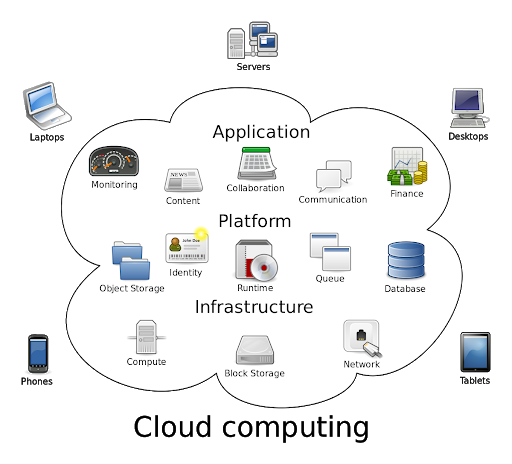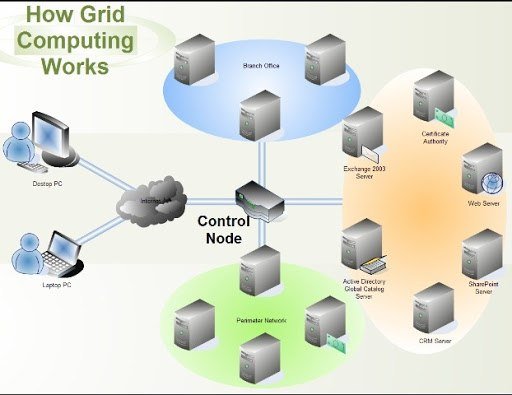In the constantly changing world, we have seen many advancements and changing of technologies, software, and resources. We also need to be continuously updated since many technologies look similar but are entirely different from each other.
Cloud computing and Grid computing are very much alike which can create confusion in anyone’s mind. The central concept of both the technologies are very similar, and the goal of both of them is to provide services by sharing data and resources to a large group of people.
Both are dependent on network technology which enables users to access one or more than one file and applications.
In cloud computing, the users can’t access the resources directly, instead uses a service via the internet whereas grid computing uses networked computer infrastructures to store a massive amount of information and data.
What is Cloud Computing?
Image Source – Wikipedia
Cloud computing is an internet-based computing system in which the resources can’t be stored or accessed directly instead of with the help of shared resources a vast pool of resources is created.
It is a type of computing paradigm which is based on the network technology for accessing resources and data remotely.
It eliminates the need for massive infrastructure and dynamically configured resources, and services can be accessed anytime.
The computing resources are located on multiple servers which are managed centrally. Any user can access their data and applications from any part of the world without worrying about the security and storing their data locally.
It also has an effective billing method where the user needs to pay according to their usage.
List of Services Offered by Cloud computing
- Software as a service (SAAS) – In this, a user does not have to worry about the platform or hardware for the creation of the final product as it removes the need of any underlying services by proving the complete product applications.
The service provider is responsible for licensing and maintenance of the application. Example – Salesforce, Google Apps, and many more.
- Platform as a service (PAAS) – It eliminates the need of infrastructure for a user by providing a robust and high-level integrated platform to create, test and design an online software or application.
Example – Microsoft Azure and Google’s Application Engine.
- These type of services emphasizes providing dedicated or virtual hardware for computing resources. Some of its services include power processing, network, disk storage, and others.
Example of Iaas providers is Flexiscale, AWS, Open stack and others.
What is Grid Computing?
Image Source – ecomputernotes
Grid computing is a type of computational system that can process a large chunk of data and information with its group of networked computers.
In this, a large number of computers are interconnected in a network and are divided into smaller grids to solve a common problem.
It is based on the model of distributed architecture which allows tasks to be managed is an efficient and distributed way without any loss in time.
In this, the computing resources are accessed seamlessly with the help of a group of computers which are distributed geographically to analyze vast sets of data and applications.
Grid Computing Vs. Cloud Computing
- Business Model
In grid computing, the grid infrastructures are used by several enterprises or groups which has the same business goal and access the virtual supercomputer to work on the same set of tasks.
However, the cost of setting and monitoring the grid is very high which has to be managed by the enterprise or project sponsors.
In cloud computing, a user using the cloud service has to pay on a pay-per-use basis to the cloud service provider. Its primary focus is to optimize the cost so that both customer and providers benefit from it.
We can compare cloud computing with other utilities like electricity or gas where we have to pay only for what we need. This type of business model is very economical and is independent of computational power usage or increased storage capacity.
Organizations today look for individuals with excellent cloud skills where an AWS cloud certification course can help individuals enhance their learnings and abilities, thus, contributing to a business’s success by scaling their growth.
- Computing Model
There is no universal standard in regards to grid computing’s system configuration.
Most of the software require major restructuring to use all the available advantages of parallel processing with grid computing.
The protocols regarding data communication are also grid specific. As most of the resources are being shared, hence the factors that govern the development of grid protocols are also very less.
Cloud computing is more flexible as compared to the grid computing because it was built primarily for commercial purposes.
For example, if you want more resources for the expansion of your business all you have to do is inform your cloud service provider to increase it.
With the help of generic software, we can even write complex codes within a few seconds.
- Security
The infrastructure of grid computing involves diverse platforms and configuration. So, it’s essential to set up each grid properly for improved system security.
Some of the critical factors include authentication, auditing, credential, and authorization.
Providing an extra security layer to the infrastructure of the grid is considered a very time-consuming process.
Cloud computing is less secure as compared to grid computing because it’s security models are straightforward. In this, it is the responsibility of the cloud providers to protect their user’s data and information.
Using private and community cloud services are some of the ways to restrict any unauthorized access.
Cloud computing uses SSL(Secure Socket Layer) to manage users accounts effectively. It encrypts the critical information such as username and password to secure your cloud account.
- Application
Grid computing is mostly utilized by academic research as it can perform operations involving a large volume of data and information.
Some of the top organizations which are using grid computing include CERN which analyzes chemical compounds for drug research and SETI which examines data from a radio telescope.
Cloud computing is an internet-based platform which eliminates the need for sophisticated hardware to build any application. Some of the top cloud computing services providers include Amazon EC2, Salesforce, Elastichosts and many more.
- Research
In grid computing, there are several resources available with the grid as a common platform. It helps in grouping the user communities in the virtual organization which are ready to solve any query or problem.
However, in cloud computing, there are a standard group of system administrators which monitors the entire system.
Final Considerations
From the above discussion, it is clear that we cannot just choose one over the other. It all depends on your requirements and what functionalities are more suitable for your business.
Cloud computing is beneficial for enterprises who want to carry out their operations in a more streamlined fashion. On the other hand, the grid computing paradigm is more suited for scientific research purposes; however, there has been significant growth in its usage in industrial, biomedical and financial research.
Cloud has more features as compared to the grid computing. Most of the internet services such as web hosting, several operating systems can be used using cloud computing.
Grid computing can be accessed from different locations as compared to the cluster systems but are considered to be more loosely coupled.






